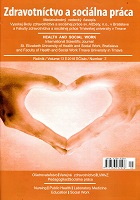Nové teoretické náhľady na arteriosklerózu
New Theoretical Perspectives on Arteriosclerosis
Author(s): Csaba Biró, Stanislava Biró Klocháňová, Miron Šramka, Štefan Durdík, Jozef ŠidloSubject(s): Health and medicine and law
Published by: SAMOSATO, s. r. o., Bratislava, Slovensko - MAUREA, s. r. o., Plzeň, Česká republika
Keywords: atherosclerosis; autoimmunity; Chlamydia pneumoniae; HSP60;
Summary/Abstract: Introduction: Based on new scientific knowledge we have in contemporary medicine, atherosclerosis is perceived as an autoimmune disease. Autoimmune diseases of the cardiovascular system represent two groups of diseases. One is the process of atherosclerosis and the other is rheumatic fever. Atherosclerosis occurs mostly in developed countries characterized by so-called western style of life, it is considered a serious medical and socio-cultural problem there. From a genetic point of view, about 160 genes are known to participate in the development of atherosclerosis. According to recent discoveries concerning autoimmune processes it is known that major changes occur at the endothelial level. Inflammatory response triggered at the endovascular or subendothelial level have all the features of the autoimmune process. Objectives and Key Results: Arteriosclerosis affects arteries. Arteriosclerotic (atherosclerotic) changes form in the inner arterial layer (tunica intima) and the outer layer (tunica adventitia). From the morphological point of view, atherosclerosis is divided into three stages. The first stage consists of lipoid strips and a lipoid plaque in which the atherosclerotic changes are still reversible. The second stage forms a fibrous plaque and an atheroma plaque, and the third stage forms atherosclerotic ulcers and calcification. The second and third stages of atherosclerosis are irreversible changes. Overall, in atherosclerosis, arterial wall thickening occurs as a result of arterial wall cellulization during the atherosclerotic macrophage process, proliferation of smooth muscle cells of tunica media, gradual increase of predominantly collagen fibers produced by activated fibroblasts and accumulation of cholesterol or rather cholesterol crystals subintimal. From a genetic point of view, there is a higher probability of atherosclerosis in monozygotic twins. Approximately 160 genes have been identified within the genome - wide association studies (GWAS), which collaborate on the development of atherosclerosis. The most important of these are three genes: TLR4, CD14, CCR2. From the point of view of autoimmune and inflammatory changes, it has been observed that people after splenectomy suffer twice as severe atherosclerosis than those without splenectomy, so called protective effect of the spleen. It is believed that people who have never undergone splenectomy, autoantibodies are produced that are directed against the major pathological antigene-oxidized low density lipoprotein prevented from creating a lipid plaque. It has been discovered that the developed lipid plaque contains T-lymphocytes, macrophages, dentrite cells and endothelial cells above the atherosclerotic plaque are mainly activated by the generation of heat shock proteins (HSP60) that cross-react with microbial heat shock proteins - especially Chlamydia pneumoniae, Helicobacter pylori, Cytomegalovirus. As a result, there is a reaction of protective antibodies, T-lymphocytes with the activation of the immune process and the occurrence of an inflammatory reaction at the level of endothelium and adventitia with depositing oxidized low density lipoproteins with the overall and local inflammatory response. Conclusion: Nowadays, thanks to contemporary laboratory methods, we are able to determine a relatively early biochemical diagnosis of atherosclerosis that is based on the mechanism of atherosclerosis: it includes the determination of levels of LDL, CRP, TNF-α, MCP-1, IL-6, IL-1β receptors, CD40L molecules and the levels of the anti-oxLDL and anti-HSP60 antibodies.
Journal: International Journal of Health, New Technologies and Social Work
- Issue Year: 13/2018
- Issue No: 2
- Page Range: 27-35
- Page Count: 9
- Language: Slovak

